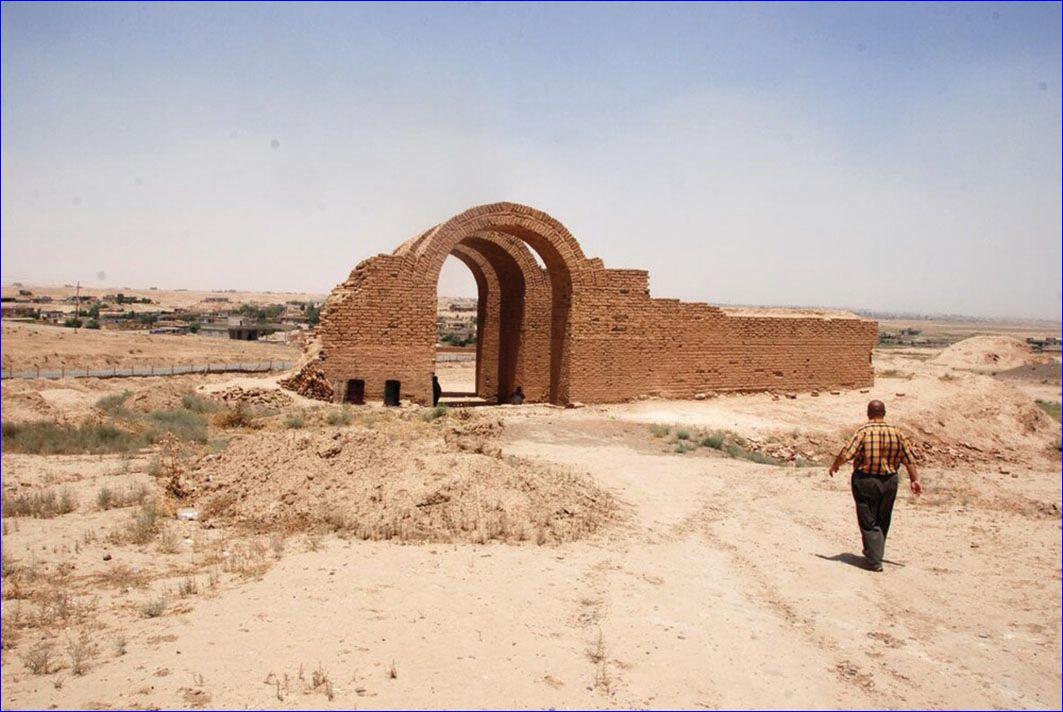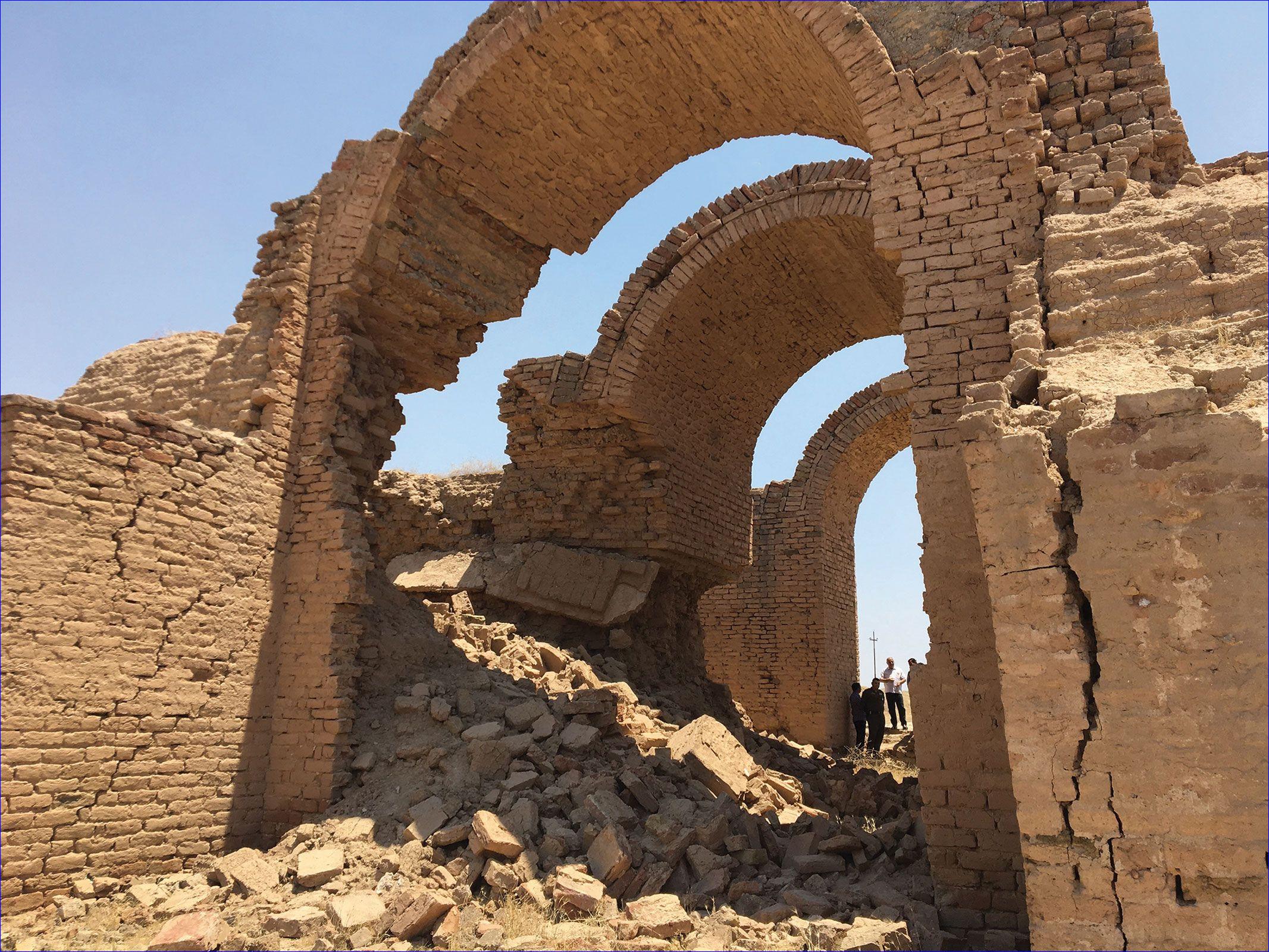


 AUIS Center for Archaeology and Cultural Heritage)
AUIS Center for Archaeology and Cultural Heritage)
The ancient city of Ashur was built on the banks of the Tigris River--in what is now Iraq--more than 5,000 years ago. Ashur was once the powerbase of the Assyrian empire, encompassing Mesopotamia, Anatolia and some of what is now Egypt, Turkey, Israel, Jordan, Lebanon and Syria. The city was believed to be the physical manifestation of the eponymous and all-powerful god who, modern scholars say, is represented in Assyrian iconography as an armed warrior in a winged sun. Today, Ashur's temple still stands, a crumbling ziggurat rising 85ft above the Tigris. It was once more than twice the height, covered in iron and lead and studded with crystals.
The city has faced destruction twice: by Babylonian forces 600 years before the birth of Jesus Christ and in 2015, at the hands of Isis. At the centre of the city stands the Tabira Gate, a monument comprised of three arches that serves as the historic symbol of the city, says Tobin Hartnell, the director of the Center for Archaeology and Cultural Heritage at The American University of Iraq, Sulaimani (AUIS). "The Tabira Gate is the unique gateway between the main sanctuary of the gods in the ina libbi (the heart of the city) and the gardens of Ishtar (the bit akītu), the goddess of war and fertility," he says.
In May 2015, Isis released a video showing its fighters attempting to turn the gateway to rubble. They succeeded in damaging 70%; more of the original structure has since fallen prey to water erosion. In 2021, Hartnell secured an emergency grant of $72,000 from the International Alliance for the Protection of Heritage in Conflict Areas, which prevented the imminent collapse of the Tabira Gate during the wet Iraqi winter of 2020. The restoration was carried out in co-ordination with the Iraqi State Board of Antiquities and Heritage and the Ministry of Culture, and ensured the gate's outer arch, which sustained the most damage during the Isis attack, was stabilised. But the structure remains weak and, without further attention, could still fall.
"We are focused on the urgent task of restoring the larger middle arch of the triple-arch gateway before the entire archway collapses," Hartnell says.
Hartnell's emergency restoration work meant the gate and the wider city joyously reopened to visitors on 1 April, the Assyrian new year celebration day. But, today, its future remains in the balance.
Around 25 miles away lies the planned site of the Makhoul Dam, first proposed by Saddam Hussein's Ba'athist regime in 2002. In 2003, Ashur was designated a Unesco World Heritage site--just as the US-led coalition invaded.
As war raged over the coming decades, the construction of the dam was forgotten. But persistent droughts brought on by climate change have blighted Iraq in recent years. With the ebbing Tigris and Euphrates rivers a threat to the country's water supply, the dam is back on the political agenda.

 AUIS Center for Archaeology and Cultural Heritage)
AUIS Center for Archaeology and Cultural Heritage)
In April 2021, construction work on the dam began again. Already, excavators can be seen laying the foundations for the main reservoir. Local families refer to 'the curse of Makhoul Dam', says Sarah Zaaimi, a researcher with the Iraqi NGO Liwan. "Everyone is anxiously waiting for the formation of the new cabinet in Iraq," Zaaimi says. "We are waiting to see whether the new minister will still want to go ahead with the project."
As plans stand, the creation of the dam threatens to flood the city of Ashur--a biblical torrent of rising river water that could drown more than 200 heritage sites in the heartland of Assyrian civilisation. Up to 250,000 people could also be displaced, according to Liwan. Khalil Aljbory, a researcher in archaeology at Tikrit University, has long studied the sociological effects of the dam on the local region. "The impact of the dam's construction has not been sufficiently studied, and to date there have been no social or environmental impact surveys carried out," Aljbory says in a Liwan statement. "As someone who has been displaced myself by previous conflicts, I fear that the construction of the dam may cause a second wave of displacement in the region."
Now, Aljbory, Zaaimi and other heritage professionals are negotiating with the Iraqi government to ensure that construction does not wantonly destroy the region's ancient monuments, as well as the lives of those who live close by. But all is not necessarily lost, says Hartnell. In fact, the dam presents local conservationists with an opportunity. "If Iraqi experts and the international community combine their efforts, then the dam's construction may spearhead a new era of cultural heritage preservation in Iraq," he says. Embracing technology, Hartnell suggests, may be the best initial approach: "The urgency of the task requires new technology to document this heritage at scale--and in record time--before it is lost under the water."
Hartnell is currently working on the installation of a new digital monitoring system that is able to determine stability levels in vulnerable structures, while the team also plan to systematically document Isis's crimes against Iraqi heritage before the evidence disappears.
This month, AUIS will begin a joint survey with Iraq's Ministry of Environment and the United Nations Development Programme to document the cultural heritage of the Central Tigris River Valley and other areas affected by the Makhoul dam. "We will discuss critical issues at the intersection of heritage and sustainable development," Hartnell says.
Top of the agenda is the creation of a temporary structure, due to begin construction this month. "But we don't believe a temporary solution will help," Hartnell says. "In fact, it might make things worse."

or register to post a comment.